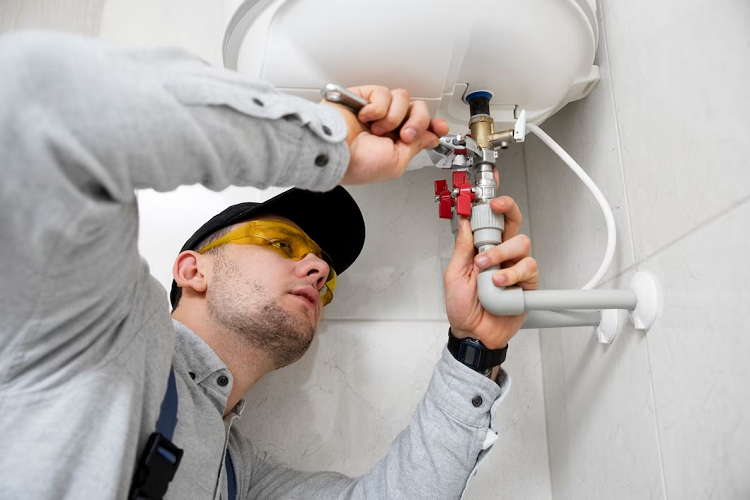A well-functioning water heater is essential for our daily comfort and convenience. From hot showers to clean dishes, we rely on hot water for various household tasks. Similar to any other household appliance, water heaters also necessitate regular maintenance to guarantee optimal performance and longevity. Failing to provide proper water heater maintenance can result in reduced efficiency, increased energy bills, and even premature failure of the unit. It is essential to prioritize routine water heater maintenance tasks to keep the water heater functioning efficiently and to avoid potential issues that could disrupt its operation and lifespan.
In this comprehensive guide, we will walk you through the essential steps of water heater maintenance. Whether you have a traditional tank-based water heater or a modern tankless system, the principles of upkeep remain similar. By following these water heater maintenance practices, you can not only extend the lifespan of your water heater but also improve its efficiency, save money on energy costs, and prevent unexpected breakdowns. So, let’s dive in and discover the key tasks involved in keeping your water heater running smoothly for years to come.
Understanding Your Water Heater
Types of Water Heaters
- Conventional storage-tank water heaters: Exploring the traditional system with a tank for storing and heating water.
- Tankless water heaters: Understanding the on-demand heating system that provides hot water without a storage tank.
- Heat pump water heaters: Learning about the energy-efficient technology that transfers heat from the air or ground to heat water.
- Solar water heaters: Discovering how solar energy is utilized to heat water, reducing reliance on conventional energy sources.
Components and Their Functions
- Storage tank: Understanding the role of the tank in storing and heating water in conventional water heaters.
- Heating element or burner: Exploring how heat is generated to raise the temperature of the water.
- Dip tube: Understanding its function in delivering cold water to the bottom of the tank.
- Anode rod: Learning how this component helps prevent corrosion within the tank.
- Temperature and pressure relief valve: Exploring its purpose in releasing excess pressure and maintaining safety.
Energy Efficiency Considerations
- Energy factor (EF): Understanding the measurement used to determine the efficiency of a water heater.
- Insulation: Exploring the importance of proper insulation to minimize heat loss and improve energy efficiency.
- Size and capacity: Considering the appropriate size and capacity of a water heater to meet household needs without wastage.
- Energy-saving settings: Learn about features such as programmable timers or vacation modes to optimize energy usage.
- Energy-efficient upgrades: Exploring additional measures like insulation blankets or heat traps to improve efficiency.
Regular Water Heater Maintenance Tasks
Checking for Leaks and Drips
- Visual inspection: Examine the area around the water heater for any signs of water accumulation, moisture, or dripping.
- Inspecting pipes and connections: Checking for leaks or loose connections in both the inlet and outlet pipes.
- Addressing leaks promptly: Understanding the importance of fixing leaks to prevent water damage and ensure efficient operation.
Flushing the Tank
- Draining the tank: Following the manufacturer’s instructions to safely drain the water heater tank.
- Removing sediment and debris: Flushing out accumulated sediment or debris that can affect heating efficiency and reduce the lifespan of the tank.
- Flushing frequency: Understanding how often the tank should be flushed based on water hardness and manufacturer recommendations.
Inspecting and Replacing Anode Rods
- Locating the anode rod: Identifying the location of the sacrificial anode rod inside the tank.
- Checking the condition: Examining the anode rod for signs of corrosion or depletion.
- Replacement interval: Understanding when and how often the anode rod should be replaced to protect the tank from rust and extend its lifespan.
Testing Pressure Relief Valve
- Locating the valve: Identifying the pressure relief valve on the water heater.
- Checking for proper operation: Testing the valve to ensure it opens and closes correctly.
- Releasing pressure: Safely discharging excess pressure through the relief valve to prevent tank damage and ensure safety.
Cleaning the Burner or Heating Element
- Turn off the power or gas supply: Following proper safety procedures to prevent accidents while cleaning.
- Removing debris or sediment: Clearing away any buildup on the burner or heating element that can hinder performance.
- Checking for damage: Inspect the burner or heating element for any signs of damage or malfunction that may require repair or replacement.
Troubleshooting and Problem-Solving
No Hot Water: Possible Causes and Solutions
- Electrical or gas supply issues: Checking if the water heater is receiving power or gas supply and troubleshooting accordingly.
- Thermostat problems: Verifying the thermostat settings and adjusting them if necessary.
- The heating element or burner malfunction: Inspecting and replacing faulty heating elements or burners.
- Sediment buildup: Flushing the tank to remove sediment that can obstruct heat transfer.
- Defective dip tube: Identifying and replacing a faulty dip tube that may be affecting hot water distribution.
Low Water Pressure: Troubleshooting Tips
- Check the pressure in other faucets: Verifying if low water pressure is limited to the water heater or a broader issue.
- Clean faucet aerators and showerheads: Removing mineral deposits or debris that may be obstructing water flow.
- Inspect pressure-reducing valve: Checking and adjusting the pressure-reducing valve if it is affecting water pressure.
- Check for pipe leaks or blockages: Examine pipes for leaks, clogs, or restrictions that may be causing low water pressure.
- Consider professional assistance: If the issue persists, contact a plumber to assess and resolve the problem.
Strange Noises: Identifying and Fixing Common Issues
- Sediment buildup: Flushing the tank to remove accumulated sediment that causes popping or rumbling sounds.
- Scaling on heating elements: Descaling or replacing heating elements affected by mineral deposits.
- Loose or damaged components: Inspecting and tightening loose parts or replacing damaged components like valves or fittings.
- Water hammer: Installing water hammer arrestors or adjusting water pressure to prevent loud banging noises.
- Consider professional inspection: If unusual noises persist or are accompanied by other issues, consult a professional plumber for further diagnosis.
Pilot Light Issues: Diagnosing and Resolving Problems
When addressing pilot light issues, it’s crucial to check the gas supply, relight the pilot light following the manufacturer’s instructions, and inspect the thermocouple for any faults. Additionally, checking for proper ventilation is essential to prevent pilot light extinguishment caused by inadequate air supply. If the pilot light continues to go out or if there are other gas-related problems, it is highly recommended for homeowners seek professional help from a qualified technician.
While attending to plumbing concerns like pilot lights, it’s also beneficial for homeowners to be well-informed about toilet repair tips.
Foul Odor or Discolored Water: Steps to Address Water Quality Issues
- Check water source: Determining if the issue is specific to the water heater or present in the main water supply.
- Flush the tank: Flush the tank to remove stagnant water and potential bacteria causing odors or discoloration.
- Check anode rod: Inspect the condition of the anode rod and replace it if necessary to address water odor problems.
- Water treatment options: Consider water treatment systems like activated carbon filters or water softeners to improve water quality.
- Consult a water quality professional: If water issues persist, consult a specialist to conduct water tests and provide tailored solutions.




